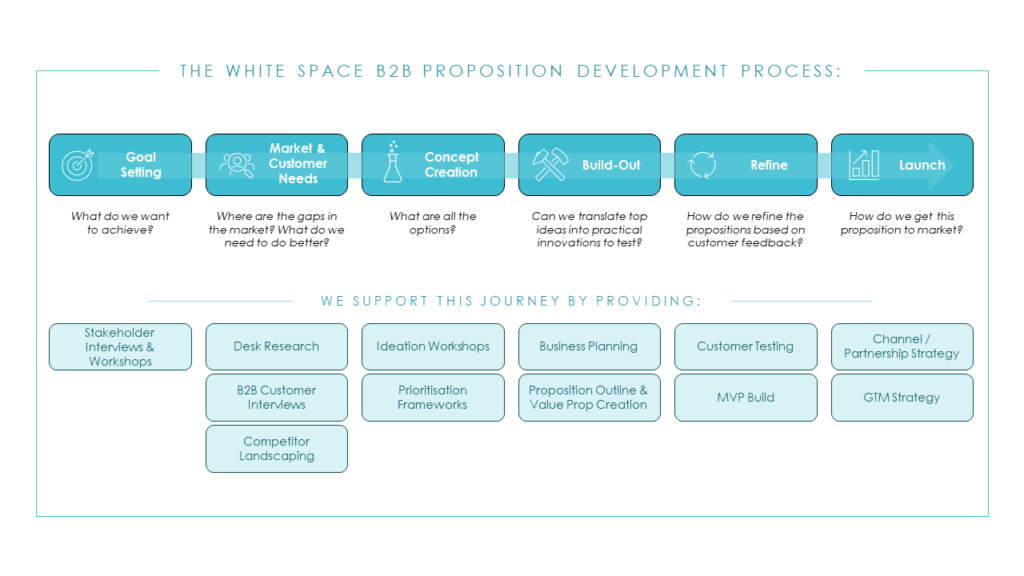Introduction
Developing a new product or service in the B2B space requires a structured approach. This process ensures that the final offering meets market needs and stands out from the competition. At White Space Strategy, we follow a detailed process to guide our clients through each stage of B2B proposition development. This blog outlines the key steps we take, from setting clear goals to launching the final product. By adhering to this method, we help businesses create successful and market-ready propositions. See how working with White Space can elevate your proposition development process.

Proposition Goal Setting
What do we want to achieve with a new proposition?
Clearly aligned and agreed goals form the foundation for the process of developing any new product or service. Without agreement on this, research is less likely to scratch beneath surface needs, concepts will be all over the place and challenging to prioritise, and the whole proposition development process is likely to get stuck and need a reboot.
Goals should help to narrow the field (make more money, or win new customers are not great final goals) but don’t need to define the solution. Good goals could be to create a product or service for an audience sub-segment, or create an evolution of an existing offering.
Before moving on, key stakeholders should have signed off on the goals and all parties should be clear about what they mean.
Market & Customer Needs
Where are the gaps in the market? What do we need to do better?
Many innovation or new product development processes jump straight to ideation, but these risk missing the opportunity for an exciting USP. By going to the market and finding customers’ unmet needs you could uncover white space for new propositions to give you a competitive advantage.
Ensuring your ideation is rooted in known requirements will give your concepts the best chance of success. This is particularly relevant for B2B organisations who might be engaging with procurement or buying contacts at their customers, and so have little insight from decision-makers at client companies and may end up prioritising price for new propositions over unmet needs.
Checking the competitor landscape at this stage also gives an idea of where others are focusing efforts and helps to rule out concepts which stray onto well-trodden ground.
Concept Creation
What are all the options for new propositions?
Bringing your creative minds together, prompting them with stimulus around needs and allowing them to free-wheel is going to give you a longlist of possible concepts to dig into further.
An initial ‘no bad ideas’ session, followed by a prioritisation session is usually best to provide a range of options to explore. It’s very possible at this point that you’ll have some ‘just do it’ ideas, and some to park for now. This shouldn’t derail the overall process, but these ideas can be passed to another team to take forward.
Build-Out
Can we translate top ideas into practical innovations to test?
Expanding on the top concepts helps provide a useful sense-check before going back to the market. How many of these could we build in a year? Who are we targeting, how often would they buy it? If we did this, roughly what price point for the customer would we be talking? What would the overall commercials look like for this – how long to get payback?
This shouldn’t be a full business plan, but addressing questions like this at a high level for a few of the top concepts will help get an idea of whether you’ve got a diamond or a dud on your hands.
For concepts that survive, putting together a short outline, including a value proposition statement, will feed into the customer testing phase.
Refine
How do we refine the propositions based on customer feedback?
Taking these proposition outlines back to customers (in some cases the same people who told you their needs in the early stages) will give a chance to see if you’ve understood their needs, and if your concepts need refinement.
We often find that presenting ideas to customers will spark further ideas – ‘that’s great, and it would be even better if…’.
Given the small number of customers in B2B markets, this can also be a great way to identify potential anchor customers or future sales leads.
Launch
How do we get this proposition to market?
Once we know we have an offer that customers are excited about and we think is deliverable on a commercial and operational basis, we need to work out how to get it to market.
If your new proposition is an evolution of an existing product or service, you may be able to sell to existing customers and through existing channels. If you’re targeting a different customer or even a different buyer at exiting customers, you may need to think about other routes to market and marketing to get the word out.
Considering other channels or partnerships and mapping the landscape might be relevant, and thinking through go-to-market based on all the customer insight from this programme can help identifying your beachhead market, and support your marketing and sales strategy.
Conclusions
It can be tempting to skip steps when you think you have a great idea, and head straight for MVP development and getting products and services in front of customers, but our experience suggests doing your diligence always ends up in a better result.
We’re always happy to help clients whose teams have developed solutions where they’re not sure of the target market, but it’s far less likely to end in disappointment if you know you’re rooting your innovation and new product development processes in verified customer needs. If you work through all these steps, you’re also more likely to discover new creative ideas, and stock the product pipeline full of interesting ideas.
B2B proposition development is part of our broader set of services around ‘building something new’. Explore our other services here, or get in touch if you have a need for support around ideation, innovation or proposition testing.


